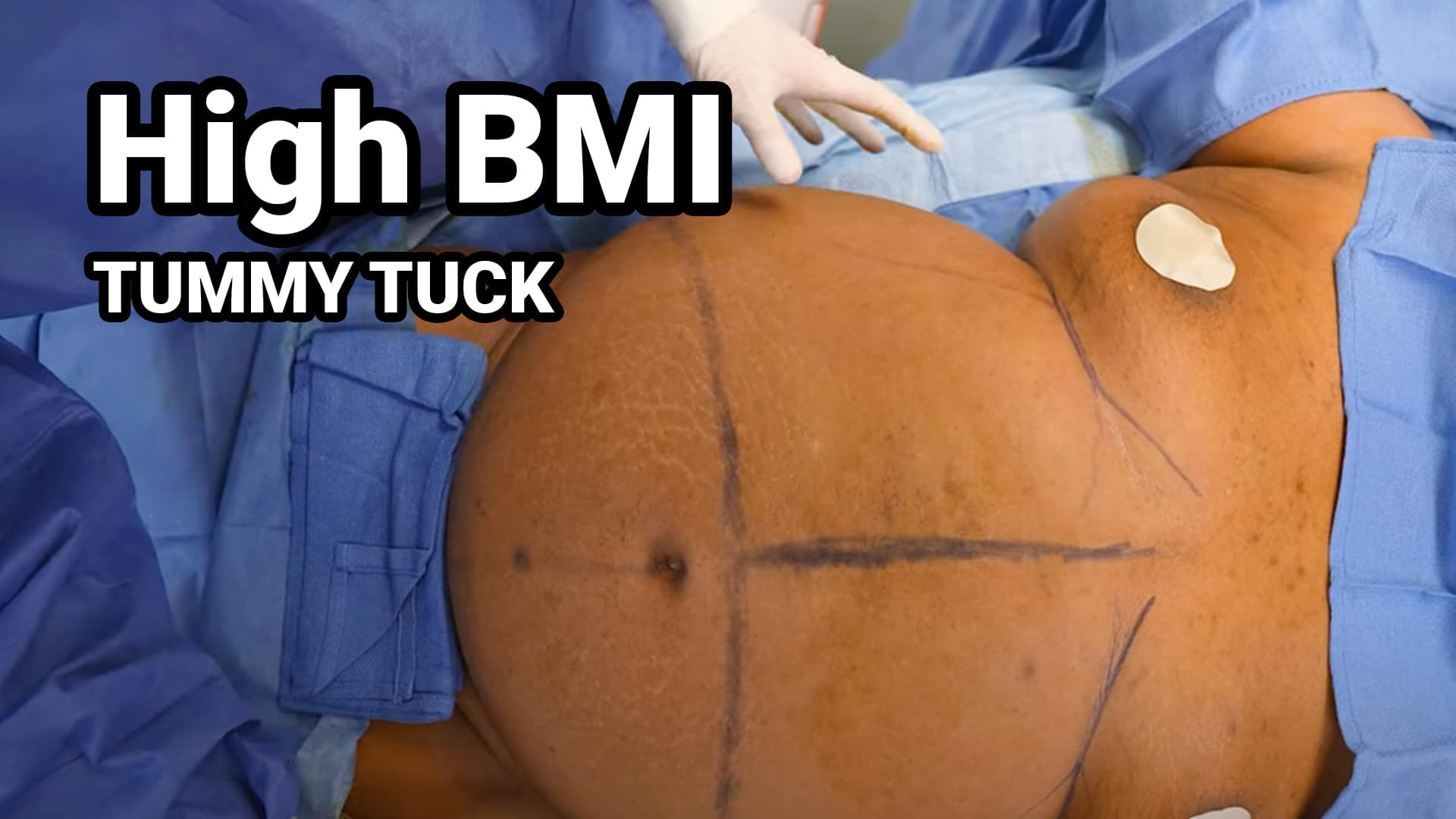
- March 31, 2023
- 10:20 am
High BMI Tummy Tuck: Life-Changing Guide
Table of Contents
High BMI (Body Mass Index) is a common challenge for people seeking to achieve a desirable body shape. Often, despite regular exercise and healthy eating, stubborn belly fat can be hard to shift, leaving many feeling frustrated and demotivated.
However, there is good news: high BMI tummy tuck, a surgical procedure that can help you achieve a flatter, toned stomach. This cosmetic surgery removes excess skin and fat, tightens the abdominal muscles, and restores your body’s youthful contours, giving you a more sculpted and streamlined appearance.
If you’re considering high BMI tummy tuck surgery, it’s important to know what to expect, including the risks and benefits, the recovery process, and the ideal candidates for this procedure.
In this life-changing guide, we’ll provide you with everything you need to know about high BMI tummy tuck, from pre-surgery preparation to post-surgery care, so you can make an informed decision and enjoy the confidence boost that comes with achieving your desired look.

BMI requirements for tummy tuck
The BMI (Body Mass Index) requirements for a tummy tuck can vary depending on the surgeon and the individual case. In general, a BMI of 30 or lower is considered optimal for tummy tuck surgery.
However, some surgeons may consider patients with a BMI up to 35 or even 40, as long as they are in good health and have realistic expectations for the surgery.
It’s important to note that a high BMI can increase the risks of complications during and after surgery, such as poor wound healing, blood clots, and infections.
Therefore, if you have a BMI higher than 30, your surgeon may advise you to lose weight through diet and exercise before undergoing tummy tuck surgery.
This will not only reduce the risks of complications but also improve the surgery results and help you maintain them long-term.
Ultimately, the best way to determine if you are a good candidate for tummy tuck surgery is to consult a board-certified plastic surgeon who can evaluate your case and provide personalized recommendations.

My BMI is 35. Can I get a tummy tuck?
While a BMI of 35 is generally considered high for tummy tuck surgery, it’s not necessarily a disqualifying factor.
The decision of whether or not to perform tummy tuck surgery on an individual with a BMI of 35 will depend on various factors, such as overall health, the amount of excess skin and fat, and the individual’s expectations for the surgery.
That being said, it’s important to note that a high BMI can increase the risks of complications during and after surgery, such as poor wound healing, blood clots, and infections.
Therefore, some plastic surgeons may advise patients with a BMI over 30 to lose weight through diet and exercise before undergoing tummy tuck surgery.
This will not only reduce the risks of complications but also improve the results of the surgery and help maintain them long-term.
Ultimately, it’s best to consult with a board-certified plastic surgeon who can evaluate your individual case and provide personalized recommendations based on your specific needs and goals.

High BMI tummy tuck near me.
States that perform High BMI tummy tuck.
It’s important to note that high BMI tummy tuck procedures can be performed in any state as long as qualified plastic surgeons are in that location.
The availability of high BMI tummy tuck providers may vary within each state. Here is a table of U.S. states with some cities that may have providers who perform high BMI tummy tucks:
| No. | State | Major Cities |
|---|---|---|
| 1 | Alabama | Birmingham, Huntsville, Mobile |
| 2 | Alaska | Anchorage, Fairbanks |
| 3 | Arizona | Phoenix, Tucson, Mesa |
| 4 | Arkansas | Little Rock, Fayetteville |
| 5 | California | Los Angeles, San Francisco, San Diego |
| 6 | Colorado | Denver, Colorado Springs |
| 7 | Connecticut | Hartford, New Haven |
| 8 | Delaware | Wilmington, Dover |
| 9 | Florida | Miami, Orlando, Tampa |
| 10 | Georgia | Atlanta, Savannah |
| 11 | Hawaii | Honolulu |
| 12 | Idaho | Boise, Idaho Falls |
| 13 | Illinois | Chicago, Springfield |
| 14 | Indiana | Indianapolis, Fort Wayne |
States that perform High BMI tummy tuck and the approximate cost.
The cost of a high BMI tummy tuck can vary depending on factors such as the surgeon’s expertise, geographical location, and the complexity of the procedure.
Below is a table of U.S. states, major cities, and an estimated cost range for a high BMI tummy tuck. Remember that these are approximate figures and can vary significantly between individual surgeons and practices.
| No. | State | Major Cities | Estimated Cost Range |
|---|---|---|---|
| 1 | Alabama | Birmingham, Huntsville, Mobile | $6,000 – $12,000 |
| 2 | Alaska | Anchorage, Fairbanks | $8,000 – $15,000 |
| 3 | Arizona | Phoenix, Tucson, Mesa | $7,000 – $14,000 |
| 4 | Arkansas | Little Rock, Fayetteville | $6,000 – $12,000 |
| 5 | California | Los Angeles, San Francisco, San Diego | $9,000 – $18,000 |
| 6 | Colorado | Denver, Colorado Springs | $7,000 – $14,000 |
| 7 | Connecticut | Hartford, New Haven | $8,000 – $16,000 |
| 8 | Delaware | Wilmington, Dover | $7,500 – $15,000 |
| 9 | Florida | Miami, Orlando, Tampa | $7,000 – $14,000 |
| 10 | Georgia | Atlanta, Savannah | $6,500 – $13,000 |
| 11 | Hawaii | Honolulu | $10,000 – $20,000 |
| 12 | Idaho | Boise, Idaho Falls | $6,000 – $12,000 |
| 13 | Illinois | Chicago, Springfield | $7,500 – $15,000 |
| 14 | Indiana | Indianapolis, Fort Wayne | $6,000 – $12,000 |
| 15 | Iowa | Des Moines, Cedar Rapids | $6,000 – $12,000 |
| 16 | Kansas | Wichita, Kansas City | $6,000 – $12,000 |
| 17 | Kentucky | Louisville, Lexington | $6,000 – $12,000 |
| 18 | Louisiana | New Orleans, Baton Rouge | $6,500 – $13,000 |
| 19 | Maine | Portland, Bangor | $7,000 – $14,000 |
| 20 | Maryland | Baltimore, Annapolis | $8,000 – $16,000 |
How can I prepare for a High BMI tummy tuck surgery?
Preparing for a high BMI tummy tuck surgery involves both physical and emotional preparation. Here are some general guidelines to help you get ready for the procedure:
- Consult with your surgeon: Have an in-depth discussion with your plastic surgeon about the procedure, its risks, potential complications, and expected outcomes. Ensure that your expectations are realistic and well-understood by your surgeon.
- Get medical clearance: Your surgeon may require you to obtain medical clearance from your primary care physician or a specialist. This is to ensure that you are healthy enough to undergo surgery and recover without complications.
- Follow pre-operative instructions: Your surgeon will provide you with specific pre-operative instructions. These may include stopping certain medications or supplements, quitting smoking, and avoiding alcohol for a specified period before surgery.
- Maintain a healthy lifestyle: Eat a balanced diet and exercise regularly to maintain or improve your overall health. This will help with the healing process and may minimize the risk of complications.
- Prepare your home: Arrange for a comfortable and clean recovery area at home. This may include a comfortable bed, pillows for elevation, and easy access to essential items like medications, water, and snacks.
- Arrange for help: Make arrangements for someone to drive you home after the surgery and to help you with daily tasks during the initial recovery period.
- Manage your expectations: Understand that the recovery process may be slow, and it can take several months for the final results to be visible. Be patient and prepared for the emotional ups and downs that may accompany the healing process.
- Prepare questions for your surgeon: Before your surgery, prepare a list of questions or concerns you may have

Risk of having Tummy Tuck surgery with a high BMI
Tummy tuck surgery, also known as abdominoplasty, carries additional risks for patients with a high BMI. While it is important to consult with a board-certified plastic surgeon to discuss your individual circumstances, here are some general risks associated with tummy tuck surgery for high BMI patients:
- Increased risk of complications: High BMI patients have a higher risk of complications such as infections, wound healing problems, seromas (fluid accumulation), and blood clots (deep vein thrombosis).
- Anesthesia risks: High BMI patients are at a greater risk of complications related to anesthesia, such as difficulty intubating, maintaining proper oxygen levels, or an increased risk of postoperative respiratory issues.
- Prolonged healing: Excess weight can lead to slower healing times, which increases the risk of complications and infection.
- Less satisfactory results: High BMI patients may experience less satisfactory cosmetic results due to factors such as excess skin, fat, or underlying muscle laxity.
- Potential need for additional surgeries: Due to the complexity of tummy tuck surgery in high BMI patients, there may be a need for additional surgeries or procedures to achieve the desired results.
- Increased risk of postoperative pain: High BMI patients may experience increased postoperative pain or discomfort, which could prolong the recovery process.
- Limited improvement in the overall shape: A tummy tuck alone may not provide the desired improvement in the overall body shape for high BMI patients. Additional procedures like liposuction, thigh lift, or arm lift may be necessary to achieve the desired outcome.

Recovery after a high BMI Tummy Tuck surgery
Recovery after a high BMI tummy tuck surgery may be more challenging than patients with a lower BMI. However, it is still manageable with proper care and following your surgeon’s instructions. Here are some general guidelines for recovery:
- Pain management: Your surgeon will prescribe pain medication to help manage postoperative pain and discomfort. Make sure to take the medication as instructed to keep pain levels under control.
- Compression garments: You may be required to wear a compression garment for several weeks after the surgery. This helps reduce swelling, improve circulation, and support the abdominal area during the healing process.
- Drains: Your surgeon may place drains to help remove excess fluid from the surgical site. Follow the surgeon’s instructions on how to care for and empty the drains. They will typically be removed within 1-2 weeks after surgery.
- Rest: Ensure you get plenty of rest during the initial recovery period. Avoid strenuous activities, heavy lifting, and any movements that could strain the abdominal area for at least 4-6 weeks or as advised by your surgeon.
- Gradual increase in activity: As you heal, gradually increase your activity level according to your surgeon’s recommendations. Start with gentle walking and increase the intensity and duration of exercises over time.
- Follow-up appointments: Attend all follow-up appointments with your surgeon to monitor your healing progress and address any concerns or complications that may arise.
- Healthy diet: Maintain a balanced, nutrient-rich diet to support your body during the healing process. Stay hydrated and avoid alcohol and smoking, as they can negatively impact your recovery.
- Scar care: Your surgeon may provide specific instructions on how to care for your incision sites and minimize scarring. This can include keeping the incisions clean and dry, applying topical ointments or silicone sheets, and avoiding direct sunlight on the scars for at least six months.
- Swelling: Swelling is normal after a tummy tuck surgery and may take several months to completely subside. Keep the surgical area elevated, especially during the first few weeks, and wear the compression garment as advised by your surgeon to help reduce swelling.
- Emotional support: The recovery process can be emotionally challenging, particularly for high BMI patients. Reach out to friends, family, or support groups to help you cope with any emotional ups and downs during your recovery.
- Patience: Understand that the recovery process may be slower for high BMI patients, and it can take several months for the final results to be visible. Be patient and give your body time to heal.
- Monitor for complications: Keep an eye out for signs of complications, such as increased pain, redness, warmth, or discharge from the incision sites, fever, or shortness of breath.
FAQ
Q1: What is a high BMI tummy tuck?
A1: A high BMI tummy tuck, also known as abdominoplasty, is a surgical procedure performed on patients with a high body mass index (BMI) to remove excess skin and fat from the abdomen and tighten the underlying muscles.
Q2: Who is a candidate for a high BMI tummy tuck?
A2: Candidates for a high BMI tummy tuck include patients with a BMI above 30 who have excess skin and fat in the abdominal area, have experienced significant weight loss, or have undergone pregnancy. It’s essential to consult with a board-certified plastic surgeon to determine if you’re a suitable candidate for the procedure.
Q3: What are the risks of a high BMI tummy tuck?
A3: Risks for high BMI tummy tuck patients include increased risk of complications (infections, wound healing issues, seromas, blood clots), anesthesia risks, prolonged healing, less satisfactory results, the potential need for additional surgeries, and increased postoperative pain.










